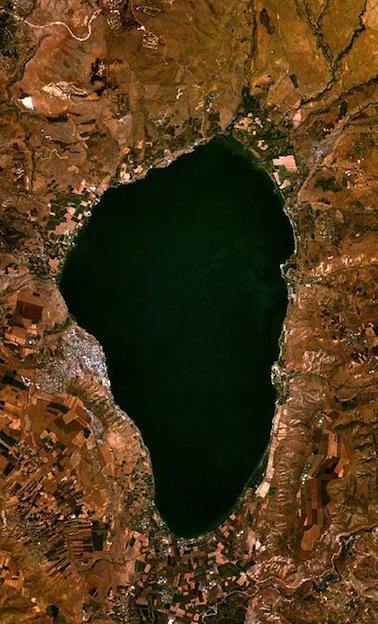SEA OF GALILEE
In many parts of the world it is called the sea, but in others, especially in the Near Eastern regions, it is known as Lake Tiberias or Lake Genesaret, more in keeping with its characteristics. It is a freshwater lake 209 meters below sea level located in the northeast of Israel, north of the Jordan Valley and on the shores of the city of Tiberias. Its watershed covers regions of both Israel and Syria and Lebanon. It is recognized among Christians for being the scene of several passages from the Bible, including Jesus walking on the water.
The Sea of Galilee is Israel's only natural freshwater lake. It has an approximate area of 164-166 km2, 20-21 kilometers in length, 12-13 kilometers in maximum width and 4 km3 in volume. Its deepest point is located in the northeast, and registers 44-48 meters, although the average depth is 25.6-26 meters. It is fed by underground springs and mainly by the Jordan River. The river flows through the lake and continues south for about 39 kilometers. Other small bodies of water, such as the Golan streams and ramblas, discharge their water from the Galilee hills.
The region of the sea usually experiences warm summers and mild winters, with an average temperature of 14ºC. Along the sea coast some important historical and religious sites remain, such as the biblical city of Capernaum.
 |
Training
The Sea of Galilee was formed as a result of tectonic processes. The valley on which it sits is the product of the separation between the Arabian plate and the African plate, and the expansion of the seabed. The depression formed towards the end of the Pliocene, and subsequently lake sediments and small amounts of water occupied a part of its area. So both the Sea of Galilee and the Dead Sea are extensions of the Red Sea Rift.
An interesting fact is that during the Quaternary period the Earth was going through a particularly wet time, and then the Dead Sea, currently south of the Sea of Galilee, expanded and extended until it reached it, but the water began to recede about of 20,000 years.
Biodiversity
The pleasant climate and the abundance of water achieve a fertile soil that favors the growth of several species of plants. The cultivation of dates, bananas, citrus fruits and vegetables has been prosperous for centuries, and along the coast it is not uncommon to see reeds. The water is home to zooplankton and various species of aquatic and semi-terrestrial crustaceans such as Potamon potamios, molluscs such as Unio terminalis and Falsipygula barroisi, microscopic algae and fish such as Tristramella simonis, Tristramella sacra Acanthobrama terraesanctae, damselfish (Pomacentridae), fish of the suborder Blennioidei, catfish , barbels and a species of tilapia (Tilapiini), which is known as San Pedro fish. Some of the fish species are closely related to some others that live in the lakes of Africa.
Until the middle of the 20th century, the European otter (Lutra lutra) was a mammal that visited the waters of the Sea of Galilee.
threats
Fishing is a basic economic activity in the Sea of Galilee region since Antiquity; however, tourism gained ground since millenary cities related to the history of Christianity are erected around it. Currently, it is a popular region to spend vacations on one of its beaches. Of course, human activities have had an impact on the health of the ecosystem.
During the years in which there are droughts, the water level drops a lot, which worries environmentalists because the sea supplies drinking water to the population of Israel, which increases its demand as it grows. It is feared that the water may become salinity due to the fact that there are salty springs below. On the other hand, the species Tristramella sacra has not been seen since the 1990s, so it is considered, in fact, extinct.
Credits: Geoenciclopedia.com


